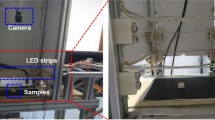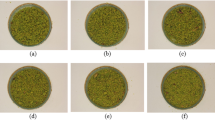Abstract
Adulteration is a major cause of concern for the food industry pertaining to health of consumers as well as economical value in the market. Rice and paddy being one of the staple diets in India, are of utmost importance when it comes to the detection and treatment of impurities and hence, in this study, various works in the same domain are examined and their limitations are brought to a close with the introduction of a novel methodology. The objective of this proposed approach is to tackle the existing problem of food grain adulteration by applying deep learning based thermal image processing techniques on thermal image samples of various types of rice and paddy grains. The methodology put forth yields an accuracy of 95% in successfully differentiating between pure and impure grains images and hence accomplish the task of adulteration detection.
V. Ponnusamy—Supervised the project and aided in data collection.
P. Anand—Worked on thermal image processing and deep learning based model development.
V. Bhatt—Worked on data manipulation, model creation and testing.
Access this chapter
Tax calculation will be finalised at checkout
Purchases are for personal use only
Similar content being viewed by others
References
FSSAI annual report (2015). https://fssai.gov.in/cms/annual-reports.php
Aggarwal, A.K., Mohan, R.: Aspect ratio analysis using image processing for rice grain quality (2010). https://doi.org/10.2202/1556-3758.1788
Asefa, B.G., Hagos, L., Kore, T., et al.: Computer vision based detection and quantification of extraneous water in raw milk. https://doi.org/10.21203/rs.3.rs-625039/v1, 06 2021
Ekambaram, D., Kumar, V.: Identification of defects in casting products by using a convolutional neural network, June 2022. https://www.researchgate.net/publication/361985340_Identification_of_Defects_in_Casting_Products_by_using_a_Convolutional_Neural_Network
Estrada-Pérez, L.V., Pradana-López, S., Pérez-Calabuig, A.M., Mena, M.L., Cancilla, J.C., Torrecilla, J.S.: Thermal imaging of rice grains and flours to design convolutional systems to ensure quality and safety (2021). https://www.sciencedirect.com/science/article/pii/S0956713520304886
Jahanbakhshi, A., Abbaspour-Gilandeh, Y., Heidarbeigi, K., Momeny, M.: Detection of fraud in ginger powder using an automatic sorting system based on image processing technique and deep learning (2021). https://www.sciencedirect.com/science/article/pii/S0010482521005588
Kumar, R.: Methods for detection of common adulterants in food (2016). https://vikaspedia.in/health/health-campaigns/beware-of-adulteration/methods-for-detection-of-common-adulterants-in-food
Chakravartula, S.S.N., Moscetti, R., Bedini, G., Nardella, M., Massantini, R.: Use of convolutional neural network (CNN) combined with FT-NIR spectroscopy to predict food adulteration: a case study on coffee (2022). https://www.sciencedirect.com/science/article/pii/S0956713522000093
Rafiq, A., Makroo, H., Sachdev, P., Sharma, S.: Application of computer vision system in food processing- a review, November 2013. https://www.researchgate.net/publication/283503760_Application_of_Computer_Vision_System_in_Food_Processing-_A_Review
Sowmya, N., Ponnusamy, V.: Development of spectroscopic sensor system for an IoT application of adulteration identification on milk using machine learning. https://ieeexplore.ieee.org/document/9393967, 2021
Torrecilla, J.S., Cancilla, J.C., Pradana-Lopez, S., Perez-Calabuig, A.M.: Detection of adulterations of extra-virgin olive oil by means of infrared thermography, January 202. https://www.researchgate.net/publication/348904072_Detection_of_adulterations_of_extra-virgin_olive_oil_by_means_of_infrared_thermography1
Zheng, M., Zhang, Y., Gu, J., Bai, Z., Zhu, R.: Classification and quantification of minced mutton adulteration with pork using thermal imaging and convolutional neural network (2021). https://www.sciencedirect.com/science/article/pii/S0956713521001821
Zhu, L., Spachos, P., Pensini, E., Plataniotis, K.N.: Deep learning and machine vision for food processing: a survey (2021). https://www.sciencedirect.com/science/article/pii/S2665927121000228
Author information
Authors and Affiliations
Corresponding author
Editor information
Editors and Affiliations
Rights and permissions
Copyright information
© 2023 The Author(s), under exclusive license to Springer Nature Switzerland AG
About this paper
Cite this paper
Ponnusamy, V., Anand, P., Bhatt, V. (2023). Classification of Adulterated Food Grain Thermal Images Using Convolutional Neural Networks. In: Shaw, R.N., Paprzycki, M., Ghosh, A. (eds) Advanced Communication and Intelligent Systems. ICACIS 2022. Communications in Computer and Information Science, vol 1749. Springer, Cham. https://doi.org/10.1007/978-3-031-25088-0_42
Download citation
DOI: https://doi.org/10.1007/978-3-031-25088-0_42
Published:
Publisher Name: Springer, Cham
Print ISBN: 978-3-031-25087-3
Online ISBN: 978-3-031-25088-0
eBook Packages: Computer ScienceComputer Science (R0)




